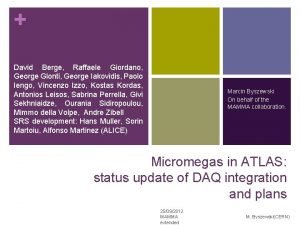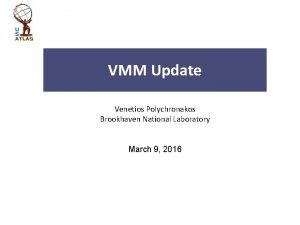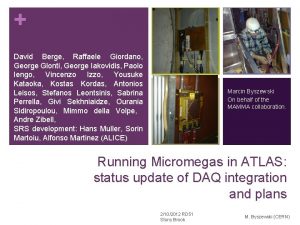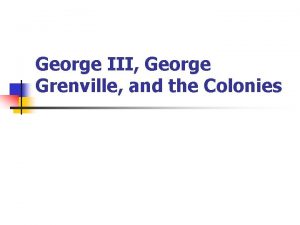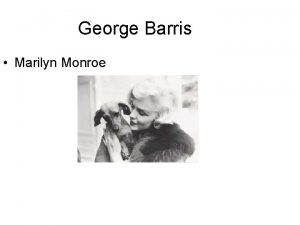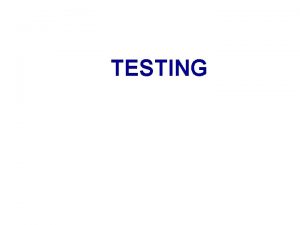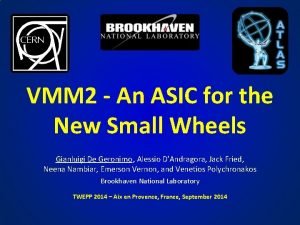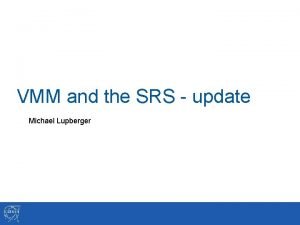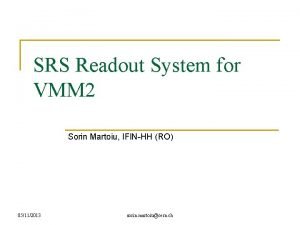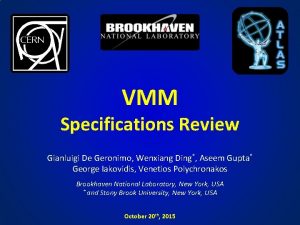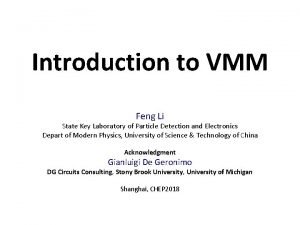VMM 3 Early Testing George Iakovidis V Polychronakos









![DACs – VMM 3 10 Pulser [m. V] vs DAC count – VMM 3 DACs – VMM 3 10 Pulser [m. V] vs DAC count – VMM 3](https://slidetodoc.com/presentation_image_h2/5ce11f24dc65bee89d4621e9c6dbcd1a/image-10.jpg)










- Slides: 20

VMM 3 Early Testing George Iakovidis, V. Polychronakos Brookhaven National Laboratory RD 51 December 12, 2016

2

VMM 3 Block Diagram

VMM 3 in the Last few months v Design submitted to MOSIS May 1, 2016 § TDS and ART chips (ATLAS NSW) were included in the reticle v 6 Engineering Wafers Received at MOSIS July 27 v Die Received at BNL in early August § Yield almost 100% § ~700 VMM 3 v BGA Substrate layout completed in mid-September, checked and sent for fabrication v 25 Production wafers were received at BNL end of September § Three wafers stolen on the way to a subcontractor in Marseille § Remaining are being packaged by Novapack (Grenoble, FR) § Received 150 packaged chips two weeks ago V. Polychronakos, Muon Week, Chios september 26 -31, 2016 4

• VMM 3 Early Tests v Received wire-bonded mini-one about a month ago (lab was being moved) v Use Lab. View based system (CDAQ, J. Fried, W. Ding) v VMM 3 specific firmware mods v UAz group assembled 2 boards with a socket base v Brought one at CERN last week v Same system but now many chips can be tested v Testing here by G. Iakovidis (with Sorin for the L 0 interface) v Similar setup at BNL v Work there by W. Ding, A. Gupta and Gianluigi v A few more of these boards will be available (UAz) in a couple of weeks 5

OK OK OK : OK= Tested, no problems found but more detailed work needed to fully characterize it OK = Verified OK OK = Tested seems to work but observe issues that need to be understood or workaround available MSB accumulation aka ADC problem shows similar behavior to the VMM 2 but do not know extend 6

OK OK 7

Early saturation comparison • 8 Distribution of PDO across all the channels, early saturation seems to be fixed. VMM 3 VMM 2 03/12/2014

Pedestals 9 03/12/2014
![DACs VMM 3 10 Pulser m V vs DAC count VMM 3 DACs – VMM 3 10 Pulser [m. V] vs DAC count – VMM 3](https://slidetodoc.com/presentation_image_h2/5ce11f24dc65bee89d4621e9c6dbcd1a/image-10.jpg)
DACs – VMM 3 10 Pulser [m. V] vs DAC count – VMM 3 03/12/2014

6 -bit adc (s. TGC direct outputs) 11 03/12/2014

VMM 3 Operating Modes v. There o o v Analog Mode (with external Digitizer, e. g. SRS C-card) Digital triggered mode (digital SRS card) Continuous triggered deadtimeless mode (simultaneous read/write) Continuous triggerless mode In the two continuous modes the digital output is in form of GBTx compatible e-links o v are basically four Data Acquisition modes Can handle up to 1 MHz trigger rate Two primitives can be used for Trigger v v Fast OR with address of the first hit strip Parallel prompt output of 6 -bit amplitudes that can be used for a more complex trigger (50 ns digitization) 03/12/2014

L 0 testing - Screenshot from the scope 13 03/12/2014

Continuous Triggered Readout 14 • L 0 logic enable works correctly, the core is functioning • IDLE state works (after swapping the DATA 0/1 lines), comma character 0 x. BC is there (k 28. 5) • OCR, BCR works correctly • Header format is correct, BCID is identified correctly • Data format is correct, relative BCID works correctly • Multiple L 0 give the correct amount of DATA • Registers are handled correctly • 8 b/10 b encoding works correctly • Truncation works • Stress tests will be performed to evaluate system performance on overflows idle header data 03/12/2014

15

BONDING DIAGRAM NOTE: reduction of wire length Vs VMM 2 design in order to keep a similar substrate routing (especially on East & West sides) 1616

LAYER M 1 (top layer) Vddp Vssd Vss Vddp Vssd 1717

LAYER M 2 (bottom layer) Vddad Vddp Vssad Vdd Vss Vddd Vddp Vdd Vssad Vddad 1818

BALL-OUT BGA 21 x 21 -400 balls VMM 3 DICE NOTE: SLVS = differential pairs (100 Ohms)1919

Summary, Next Steps v So far VMM 3 seems to be mostly OK v Differential nonlinearity of the 10 -bit and 8 -bit ADC still there but perhaps to a lesser extend, testing is on-going v Analog mode (of interest perhaps to the RD 51 community) is fine and can be used if desired v Samples can be available to those interested § ~30 unpackaged dice reserved for RD 51 tests v If ADC performance is good enough for NSW a large order will be placed ~May 2017. v We can add quantities for any group that may be interested v No export license needed § CERN working for a universal license for all ASICs fabricated by Global Foundries, please check with P. Farthouat 20
 David berge
David berge Vmm intel virtualization technology
Vmm intel virtualization technology Early cpr and early defibrillation can: *
Early cpr and early defibrillation can: * Venn diagram ghent
Venn diagram ghent Differences between george washington and king george iii
Differences between george washington and king george iii Jenis jenis black box testing
Jenis jenis black box testing Positive vs negative testing
Positive vs negative testing Testing blindness in software testing
Testing blindness in software testing Language testing
Language testing What is domain
What is domain Black-box testing disebut juga sebagai behavioral testing
Black-box testing disebut juga sebagai behavioral testing Static testing and dynamic testing
Static testing and dynamic testing Component testing is a black box testing
Component testing is a black box testing Control structure testing in software engineering
Control structure testing in software engineering Logic based testing
Logic based testing Extended entry decision table
Extended entry decision table Localization globalization testing
Localization globalization testing Types of domain testing
Types of domain testing Advantages and disadvantages of decision table
Advantages and disadvantages of decision table Decision table testing in software testing
Decision table testing in software testing Du path testing
Du path testing
